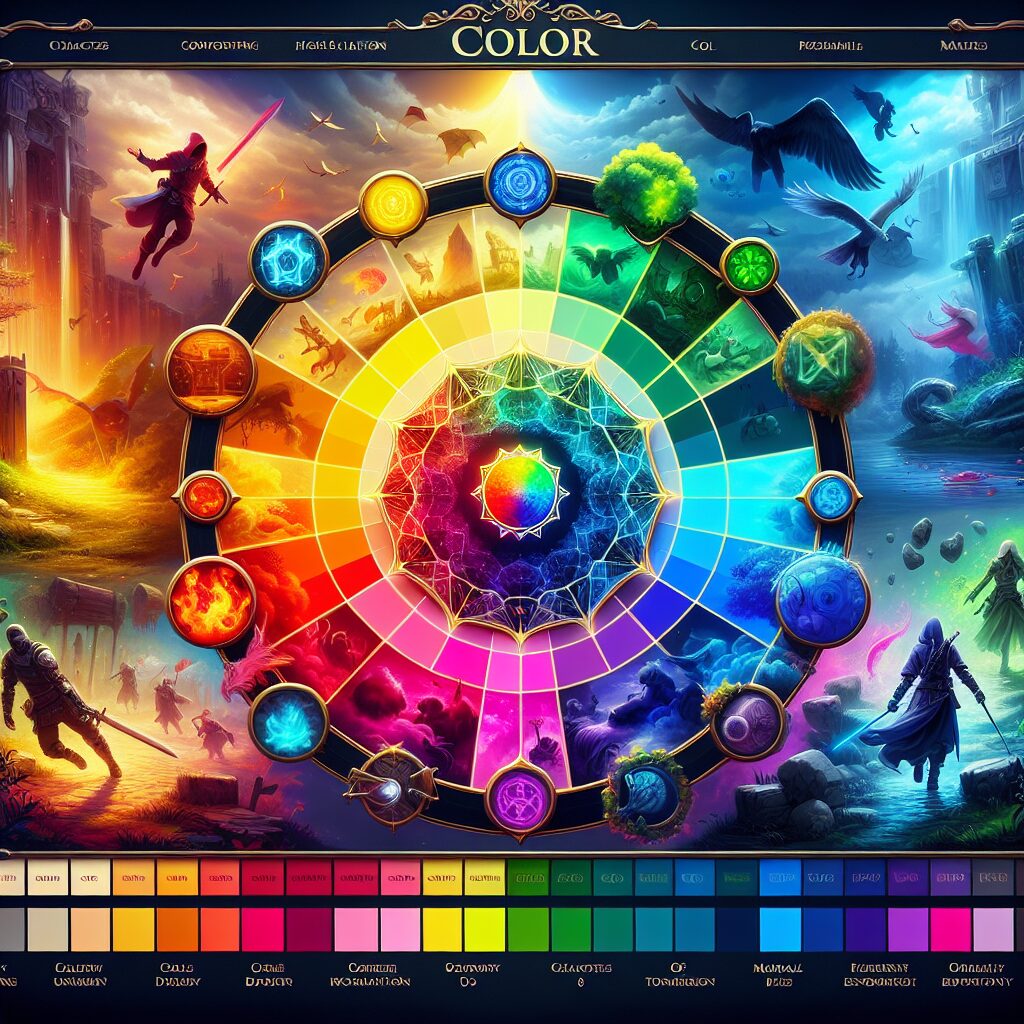Color is a powerful tool that holds the ability to evoke emotions and influence our perception of the world around us. Whether it’s in art, design, or even video games, colors play a crucial role in shaping our experiences. In the realm of gaming, color influences not only the aesthetics but also the gameplay and overall player experience. Game developers understand the significance of color psychology and utilize it strategically to enhance immersion, create atmosphere, and elicit specific emotional responses from players.
In games, color influences everything from the environment to the characters, objects, and even the user interface. The choice of color palette sets the tone and mood of the game, making it an essential aspect of the overall design. For example, vibrant and saturated colors often create a sense of excitement and energy, while muted and desaturated tones can convey a feeling of melancholy or mystery. Additionally, specific colors can be associated with different themes or genres, such as red for danger or blue for calmness.
Now that we understand the impact of colors in games, let’s delve into the key takeaways that highlight the various ways in which color influences the player experience. In the upcoming sections, we will explore the psychological effects of different colors, the role of color in gameplay mechanics, and how color can be used to guide and direct players. By comprehending the intricate relationship between color and gaming, we can unlock a deeper understanding of the immersive worlds that captivate us. So, let’s embark on this colorful journey and uncover the secrets of color influences in games.
Key Takeaways
1. Color plays a significant role in shaping the overall player experience in video games, influencing emotions, attention, and cognitive processes.
2. Warm colors such as red and yellow are often associated with excitement, energy, and danger, while cool colors like blue and green convey feelings of calmness, tranquility, and safety.
3. Different color schemes and contrasts can enhance visual clarity, improve readability, and help players effectively navigate through game environments and interfaces.
4. Colors can be used strategically to represent specific themes, moods, or narrative elements, creating a cohesive and immersive experience that aligns with the game’s intended message or story.
5. By understanding the psychological and cultural associations of colors, game developers can effectively utilize color palettes to evoke desired emotional responses and enhance the overall player engagement and enjoyment.
What are the Color Influences in Games: Shaping the Player Experience?
Understanding the Power of Color in Games
Color plays a significant role in shaping the player experience in games. It can evoke certain emotions, set the mood, and guide the player’s attention. The strategic use of color can greatly impact how players perceive and engage with a game.
The Psychology Behind Colors
Different colors have different psychological effects on individuals. For example, warm colors like red and yellow typically evoke feelings of excitement and energy, while cool colors like blue and green tend to create a sense of calmness and relaxation. Understanding these psychological effects is crucial in utilizing color to influence players’ emotions and experiences.
Color Association and Symbolism
Colors are often associated with specific meanings and symbolism. For instance, red can symbolize danger or passion, while green may represent growth or nature. Incorporating these associations into the game’s design can enhance the storytelling and overall player immersion.
Creating a Harmonious Color Palette
A well-designed color palette should be visually appealing and harmonious. Consider the color theory principles, such as complimentary colors, analogous colors, and color temperature, to create a cohesive and balanced visual experience for players.
Practical Tips for Designing with Color in Games
1. Use Color to Indicate Importance
Utilize color to draw attention to crucial elements in the game, such as objectives, enemies, or collectibles. Bright and contrasting colors can help highlight these important elements and guide the player’s focus.
2. Adjust Color for Different Environments
When designing games with multiple environments or levels, consider adapting the color palette to reflect the mood and setting of each area. For example, using warmer tones for a fiery volcano level or cooler tones for an underwater level can enhance the immersion and reinforce the game’s narrative.
3. Consider Color Accessibility
Accessibility is crucial in game design. Ensure that your color choices consider individuals with color vision deficiencies or impairments. Avoid relying solely on color to convey information, and provide alternative visual cues or labels to ensure inclusivity.
4. Experiment with Color Harmony
Explore different color combinations and experiment with various palettes to achieve the desired atmosphere and emotional impact. Balance contrasting and harmonious colors to create visual interest while maintaining a cohesive overall aesthetic.
5. Leverage Color Contrasts
Using contrasting colors can help make important elements stand out in the game. Utilize the principles of contrast, such as light/dark contrast or hue contrast, to enhance visibility and readability. This technique is particularly useful for text, user interface elements, or interactive objects within the game.
6. Test and Iterate
Finally, continuously test and iterate your color choices based on player feedback. Colors may have different effects on different players, so it’s important to gather insights and make adjustments accordingly to optimize the player experience.
What is the impact of color in game design?
1. How can color influence the player experience in games?
2. What psychological effects do different colors have on players?
3. How can designers incorporate color associations and symbolism in game design?
4. What are the principles of creating a harmonious color palette in games?
5. How can color be used to indicate importance in game design?
6. How should color be adapted for different environments or levels in games?
7. What considerations should be made for color accessibility in game design?
8. How can designers experiment with color harmony in games?
9. What are the benefits of leveraging color contrasts in game design?
10. Why is continuous testing and iteration important when it comes to color choices in games?
Frequently Asked Questions
1. How do colors influence player experience in games?
Colors have a significant impact on the player experience in games. They can evoke emotions, set the tone, and enhance the overall atmosphere of the game world. Different colors have different psychological effects on players and can influence their mood, perception, and engagement.
2. Can colors affect gameplay mechanics?
Yes, colors can affect gameplay mechanics in games. For example, certain colors can be associated with specific actions or interactions, creating a visual language within the game. Color coding can also be used to highlight important elements or provide visual cues to guide players through the gameplay experience.
3. What role do colors play in storytelling?
Colors play a vital role in storytelling within games. They can help convey the narrative, define the setting, and represent different themes or character traits. By using appropriate color palettes, game developers can enhance the player’s immersion and emotional connection to the story being told.
4. Are there any cultural considerations for color influences in games?
Yes, cultural considerations are essential when using color influences in games. Different cultures associate different meanings with colors, so it’s crucial to be aware of cultural contexts to avoid misinterpretations or offensive representations that may affect players negatively.
5. How can colors be used to guide player attention?
Colors can be used strategically to guide player attention in games. By contrasting colors or using bright hues, developers can draw attention to important elements, such as objectives, enemies, or interactive objects. Additionally, using subtle color changes can help indicate progression or changes within the game world.
6. Can colors affect player performance in games?
Yes, colors can affect player performance in games. Research has shown that certain colors can improve focus, increase reaction times, and enhance visual clarity. By using color schemes that optimize visibility and reduce eye strain, game developers can create an environment that promotes better gameplay performance.
7. How can colors contribute to multiplayer experiences?
Colors can contribute to multiplayer experiences by aiding in player identification and team differentiation. Using distinct color palettes for different teams or players allows for quick visual recognition and reduces confusion during multiplayer gameplay. Color choices can also help establish a unique identity for each player or team.
8. What impact do colors have on player emotions?
Colors have a powerful impact on player emotions in games. Warm colors, such as red and orange, can evoke excitement and intensity, while cool colors, like blue and green, can create a more calming or soothing atmosphere. By understanding the emotional responses to colors, game developers can tailor the player experience accordingly.
9. Can colors affect player immersion?
Absolutely, colors can have a significant influence on player immersion in games. By using cohesive and immersive color palettes, game developers can create a visually captivating world that draws players into the game’s narrative and environment. Well-chosen colors can enhance the sense of being part of the game world and increase overall immersion.
10. What considerations should be made when choosing colors for game design?
Several considerations should be made when choosing colors for game design. First, the game’s intended mood, atmosphere, and narrative should be taken into account. Additionally, color combinations that provide adequate contrast and legibility must be considered to ensure accessibility for all players. Lastly, cultural associations, target audience preferences, and potential color symbolism should also be considered for an inclusive and impactful game design.
Final Thoughts on Color Influences in Games: Shaping the Player Experience
The impact of color influences in games cannot be underestimated. The strategic use of colors can shape player experiences, amplify emotions, and enhance immersion in the virtual worlds we explore. Through careful consideration of color palettes, cultural contexts, and gameplay mechanics, game developers have the power to craft unforgettable experiences that resonate with players on a deep and meaningful level.
As players, we should appreciate and acknowledge the thought and effort that goes into choosing and implementing colors in games. The immense potential of colors to influence our emotions, guide our attention, and create memorable experiences is a testament to the artistry and craft behind game design. So, next time you dive into a game and are captivated by its vibrant visuals, take a moment to recognize the role of colors in shaping your player experience.




